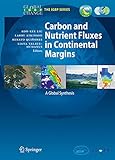Carbon and Nutrient Fluxes in Continental Margins [electronic resource] : A Global Synthesis / edited by Kon-Kee Liu, Larry Atkinson, Renato Quiñones, Liana Talaue-McManus.
Series: Global Change – The IGBP SeriesPublisher: Berlin, Heidelberg : Springer Berlin Heidelberg, 2010Edition: 1Description: XXVIII, 744 p. 278 illus., 90 illus. in color. online resourceContent type:- text
- computer
- online resource
- 9783540927358
- 551.46 23
- GC1-1581
 eBooks
eBooks
Perspectives and Regional Syntheses -- Biogeochemistry of Continental Margins in a Global Context -- Eastern Boundary Current Systems -- Western Boundary Currents -- Indian Ocean Margins -- Subpolar Margins -- Polar Margins -- Marginal Seas -- Tropical Margins -- Arising Issues and New Approaches -- Examining Human Impacts on Global Biogeochemical Cycling Via the Coastal Zone and Ocean Margins -- Biogeochemical Transformations of Silicon Along the Land–Ocean Continuum and Implications for the Global Carbon Cycle1 -- Submarine Groundwater Discharge (SGD) and Associated Nutrient Fluxes to the Coastal Ocean -- Coupled Circulation/Biogeochemical Models to Estimate Carbon Flux1 -- Cross-Boundary Fluxes and Global Synthesis -- Cross-Boundary Exchanges of Carbon and Nitrogen in Continental Margins1 -- Carbon–Nitrogen–Phosphorus Fluxes in the Coastal Zone: The LOICZ Approach to Global Assessment -- Sediment and Carbon Accumulation on Continental Shelves1 -- Global Synthesis1.
This book is a product of the joint JGOFS (Joint Global Ocean Flux Study)/LOICZ (Land–Ocean Interactions in the Coastal Zone) Continental Margins Task Team which was established to facilitate continental margins research in the two projects. It contains signi cant information on the physical, biogeochemical, and ecosystems of continental margins nationally and regionally and provides a very valuable synthesis of this information and the physical, biogeochemical and ecosystem processes which occur on continental margins. The publication of this book is timely as it provides a very strong foundation for the development of the joint IMBER (Integrated Marine Biogeochemistry and Ecosystems Research)/LOICZ Science Plan and Implemen- tion Strategy for biogeochemical and ecosystems research in the continental margins and the impacts of global change on these systems. This initiative will move forward integrated biogeochemical and ecosystems research in the continental margins. We thank all the contributors to this volume and especially Kon-Kee Liu who has dedicated a great deal of time to ensuring a high-quality book is published. IMBER Scienti c Steering Committee Julie Hall LOICZ Scienti c Steering Committee Jozef Pacyna v 1 Preface In general, interfaces between the Earth’s larger material reservoirs (i. e. , the land, atmosphere, ocean, and sediments) are important in the control of the biogeoche- cal dynamics and cycling of the major bio-essential elements, including carbon (C), nitrogen (N), phosphorus (P), sulfur (S), and silicon (Si), found in organic matter and the inorganic skeletons, shells, and tests of benthic and marine organisms.


